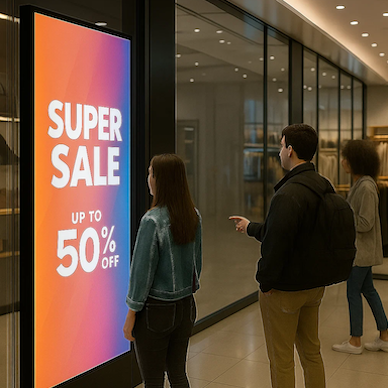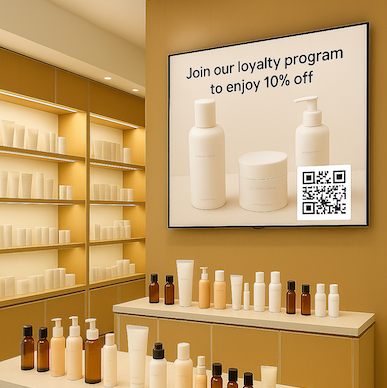Developing a Content Strategy for Digital Signage: Key Steps for Success
In today's fast-paced digital world, capturing and retaining your audience's attention is more challenging than ever. That's where a well-crafted content strategy for digital signage comes into play. By tailoring content to meet the specific needs and interests of your target audience, we can make our digital displays not just eye-catching, but also profoundly impactful.
A robust content strategy ensures our messages are clear, concise, and engaging. With digital screens vying for attention everywhere, delivering relevant and compelling content can significantly boost brand awareness and even drive sales. When we understand our audience and communicate effectively, we maximize our investment in digital signage and see a substantial return on investment. Let's dive into the essentials of developing a winning content strategy for digital signage.
Understanding Digital Signage Content Strategy
Developing a solid content strategy for digital signage is crucial to maximize engagement and effectiveness. This strategy ensures that the content is both impactful and aligned with the organization’s objectives.
Assessing Purpose and Goals
Before creating content, we need to define our purpose and goals. Determine whether the aim is to increase sales, enhance brand awareness, or provide information. By identifying specific objectives, we can tailor the content to meet these goals. For example, promotional messages may focus on highlighting product benefits, while informational content might emphasize service details or company values.
Knowing Your Audience
Understanding who the target audience is forms the core of any content strategy. Analyze demographics, interests, and behaviors to craft relevant messages. For instance, content for a young demographic could feature vibrant visuals and trending themes, whereas messages for a professional audience might prioritize clarity and formal tone.
By integrating these principles—assessing purpose and goals and knowing the audience—our digital signage content will be both effective and engaging.
Key Components of Effective Digital Signage Content
Effective digital signage content must be engaging, visually appealing, and tailored to the target audience. Here are the key components to consider:
Visual Design and Brand Consistency
Visual design is crucial in digital signage. High-quality images and vibrant colors grab attention immediately. It's important to use consistent branding elements, including colors, fonts, and logos. This consistency reinforces the brand's identity and fosters familiarity among viewers. Capitalizing on white space helps draw attention to prominent text and ensures the display isn't overloaded with too much information.
Creating Engaging and Dynamic Content
Content must be engaging and dynamic to capture viewers' attention effectively. Interactive elements, real-time news feeds, and social media connections can make the display more interesting. Regularly updating content ensures relevance and keeps viewers engaged. Clear and concise messaging is critical; short, readable text holds viewers' attention better than lengthy descriptions. Including calls to action (CTAs) encourages interaction and guides viewers on the next steps, such as making a purchase or signing up for a newsletter.
Managing and Optimizing Digital Signage Content
Effective digital signage content management involves strategic scheduling, placement, and constant adjustment based on performance data.
Content Scheduling and Strategic Placement
Content scheduling allows us to deliver the right message at the perfect time. By analyzing consumer behavior and peak engagement times, we can schedule content to ensure maximum visibility. Consider the following to optimize scheduling:
- Timing: Adjust content display times based on audience habits. For example, promotional offers can align with peak shopping hours.
- Frequency: Rotate content to prevent viewer fatigue and maintain engagement. Balance static and dynamic messages to keep the audience interested.
- Relevance: Ensure the content aligns with current trends or events. Display weather-related products during adverse conditions or promotions during holidays.
Strategic placement enhances the visibility and impact of digital signage content. Position screens in high-traffic areas and at eye level to capture attention effectively. Here are key considerations:
- Location: Place screens where foot traffic is highest, such as entrances and waiting areas.
- Visibility: Ensure screens are easily seen from multiple angles, avoiding obstructed lines of sight.
- Context: Tailor content to the surroundings. In a retail environment, display product promotions. In a corporate setting, focus on brand messages and announcements.
Measurement and Adjustment Tactics
Measuring content performance is crucial for continuous improvement. By evaluating key metrics, we can refine strategies to better achieve our goals. Focus on the following metrics and tactics:
- Engagement Metrics: Track viewer engagement through interactions like touch, dwell time, and foot traffic. Tools like Nexmosphere provide real-time data on these interactions.
- Sales Data Analysis: Compare sales figures before and after displaying promotional content. If a product's sales increase during promotions, that's a clear indicator of effective content.
- Audience Feedback: Collect direct feedback for qualitative insights. Surveys and feedback forms can reveal how the audience perceives the content.
Adjust content based on performance data to maintain relevance and effectiveness. This involves:
- Content Refresh: Regularly update visuals and messages to align with changing trends and feedback.
- Targeted Adjustments: Refine content to better match the demographics and preferences of the audience. For instance, if younger audiences frequent a location more often, tailor messaging to their interests.
- Performance Reviews: Conduct periodic reviews of content performance to identify what works and what doesn’t. Make informed tweaks to enhance engagement and sales impact.
Effective management and optimization of digital signage content involve detailed scheduling, strategic placement, continual measurement, and timely adjustments. By following these guidelines, we ensure our digital signage remains engaging and effective.
truDigital: Your Partner in Digital Signage Content Strategy
Selecting a partner experienced in digital signage content strategy is crucial for maximizing the impact of your campaigns. truDigital stands out with its expertise and dedication to crafting customized solutions that fit your specific needs. We understand that each organization has unique objectives, and our approach ensures that your content aligns seamlessly with your goals.
Customized Content Solutions
truDigital prioritizes tailored content that resonates with your audience. Whether the goal is to entertain, inform, promote products, or cross-sell, we design content playlists that match your strategic objectives. In retail settings, for example, our promotional content can drive consumer behavior through compelling calls to action (CTAs). We measure effectiveness by comparing sales numbers before and after promotions, ensuring quantifiable results.
Strategic Playlist Development
The structure, length, and mix of your content playlist should reflect your organization's goals and your customers' needs. truDigital helps create playlists that balance various content types. If the aim is to boost engagement, we incorporate a higher percentage of entertaining and informational pieces. For sales-focused campaigns, we prioritize promotional content to drive purchases. Each playlist is crafted to keep your audience engaged and aligned with your business goals.
Contextual Relevance
Context is key to meaningful digital signage experiences. truDigital leverages contextual relevance to engage audiences at the right moment. For example, displaying rain gear promotions during a downpour or featuring concessions ads right before movie showings can significantly boost engagement. Our strategy focuses on aligning content with real-world events to enhance its effectiveness.
Partnering with truDigital ensures that your digital signage content strategy is not only effective but also meticulously optimized to meet your unique objectives. With a focus on tailored content, strategic playlist development, optimized files, and contextual relevance, truDigital stands as a leader in the digital signage space.
Conclusion
Developing a robust content strategy for digital signage isn't just about creating visually appealing displays; it's about crafting messages that resonate with our audience and drive meaningful engagement. By leveraging technology and data, we can ensure our content is both timely and relevant. Partnering with experts like truDigital can provide the tailored solutions we need to align our digital signage with our organizational goals. Let's focus on strategic planning and continuous optimization to maximize the impact of our digital signage campaigns
See it in Action
Get a free, no-pressure demo of our unique platform and find out how it can transform your business.









